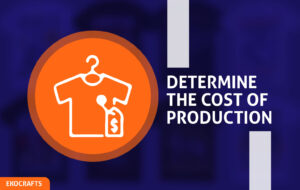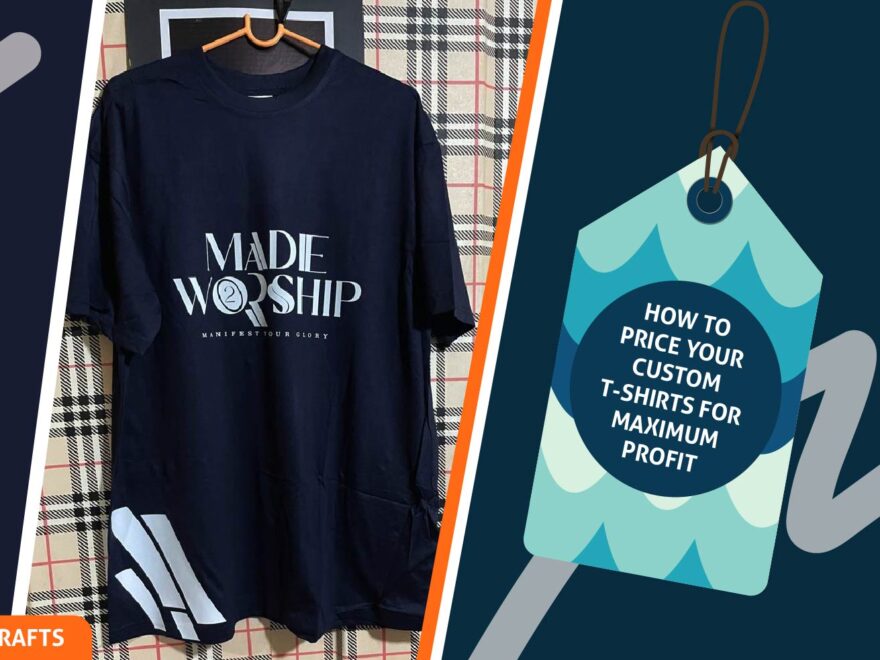You wouldn’t want to run at a loss producing your quality t-shirts. Setting your custom t-shirt prices wisely is essential to maintaining profitability and market competitiveness. Pricing your t-shirts can be pretty challenging as a t-shirt designer and a seller if you do not know the right process and method to use to achieve your expected end.
You should consider that, in breaking through the market you should charge at a fair rate; making sure that your price can meet the production cost and also your profit.
In this article, we will elaborate on some essential elements that you need to consider in pricing your custom t-shirts. And some formulae that you can use to achieve the best pricing results for your business.
To price your custom t-shirts, you must determine the production cost, overhead cost, packaging, and shipping, transaction cost, and cost-plus printing, value-based pricing, competitive pricing, factor in bulk orders.
Essential Elements to Consider in Pricing Your Custom T-Shirts.
1. Determine the Cost of Production:
The first stage in determining your t-shirt pricing is understanding your production costs. Production cost is usually the total expenditure incurred for producing your custom t-shirt. You need to make sure that you factor in any other form of material such as tags, labels, and any form of embellishment.
i. Material Costs
Fabric: The cost is considerably influenced by the type of fabric used (cotton, polyester, blends). Higher-quality materials are typically more expensive compared to lesser quality. You should decide on the target audience that you are producing the t-shirts for. Clients who are willing to pay more for your t-shirts should have quality fabrics as compared to clients who do not have many resources to pay for quality fabrics.
ii. Designing Cost: You should consider adding your design fee as a production cost. This is the best way to reward yourself for the incredible efforts that you put into making your custom t-shirt designs. Adding your design cost will give you the zeal to continuously make designs that you would sell to your clients.
iii. Printing Costs: You should consider the price of the various printing techniques that you intend to use for printing your custom t-shirts. Such as (heat transfer, direct-to-garment, and screen printing)

2. Overhead Costs:
Labor: When recruiting employees or outsourcing production considering the labor cost is very essential.
Utilities: Take into account the price of electricity, water, and other production-related utilities.
Rent: If you have a physical location or studio, incorporate a portion of the rent.

3. Packaging and Shipping: If you intend to deliver directly to customers, take into account the price of shipping and the packaging materials you intend to use to package the finished printed t-shirt. These packaging materials can be boxes, paper bags, or plastic bags.

4. Transaction Fees
If you sell online, you must include transaction fees for platforms such as Etsy or Shopify in the final price of the material.
BEST STRATEGIES FOR PRICING YOUR CUSTOM T-SHIRTS
To understand the best strategy for pricing your custom shirts, let’s use this sample calculation as a model.
Example Calculation:
Let’s assume the total production cost per shirt is:
- Material: $6.00
- Printing: $3.00
- Packaging: $1.00
- Shipping: $1.00
- Transaction Fees: $0.35
Total Production Cost = $11.35
The Various Pricing Strategies
It is time to understand the various pricing strategies that you can use to price your t-shirts. Here is a list of the different strategies you can adopt to achieve the expected end.
1. Cost-Plus Pricing
This approach involves adding a markup percentage to your total production cost to ensure profit.
For example:
• If you decide on a 50% markup:
Selling Price = Total Production Cost + (Total Production Cost x Markup)
Selling Price = $11.35 + ($11.35 x 0.50)
= $17.02
2. Value-Based Pricing
This strategy focuses on how much customers are willing to pay based on the perceived value associated with your custom t-shirts rather than just the mere costs. This is the belief that customers have for your work. Get first-hand knowledge of your target audience and understand their preference and how much they are willing to pay for the printed custom t-shirts that you have made. This gives the ability to charge them according to the cherished value of the printed t-shirts. Let your design be unique, trendy, and sustainable as it will draw more people to your store.
c. Competitive Pricing
You should research to find out the price that other competitors in your niche are pricing their custom t-shirts similar to yours. You can do this by:
• Identify the price range for comparable t-shirts.
• Position your pricing accordingly—either matching competitors or setting yourself apart with premium pricing if you offer superior quality or unique designs.
3. Factor in Bulk Orders
You can encourage bulk orders by slightly reducing the prices to make room for individuals who want to sell your crafts. Encouraging bulk purchases can also increase sales volume while maintaining profitability.
a. Discount Structure
Discounting your prices is a great way to beat the competition in your niche. Offer whooping and appreciative discounts that customers and retailers are going to love and appreciate. Doing this will help you achieve more sales which will translate into more profit. This can help you as a guide if you want to know how to discount your custom t-shirts.
For example:
1-10 shirts: $17 each
11-50 shirts: $15 each
51+ shirts: $12 each
This not only incentivizes larger orders but also helps reduce per-unit costs due to economies of scale.
b. Wholesale Pricing
If you plan to sell to retailers or businesses, establish a wholesale price that allows them to resell at a profit while still being attractive to their customers.
4. Test and Adjust Your Prices
Testing and adjusting your price is a great step to knowing how your price is doing on the market and is also able to help you meet your financial goals. If sales are high, it will mean that your price is cool or your price is super low. Have a monitoring eye to see how your price is doing well and adjust it accordingly to meet the price on the market and your expectations. Testing and adjusting your price is essential for:
a. Sales Performance
Track how well different price points perform over time:
If certain designs sell well at higher prices, consider adjusting other designs similarly.
b. Customer Feedback
Engage with customers through surveys or social media to gauge their perception of value and pricing.
c. Seasonal Adjustments
Consider seasonal trends that might affect demand—during holidays or events, you might adjust prices or offer promotions.
5. Promote Your Value Proposition
Finally, ensure that potential customers understand what makes your t-shirts worth the price.
You should highlight the use of quality materials, unique designs, ethical production practices, how your custom t-shirt gives clients comfort, confidence, and assurance, or any other aspects that differentiate your brand from the rest of other producers. Utilize social media marketing, email campaigns, and engaging content to leverage your sales effectively.
